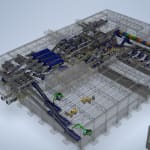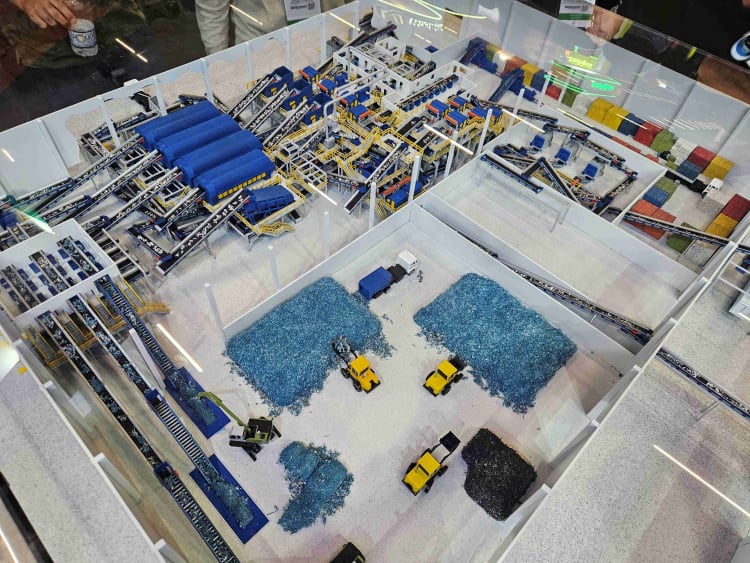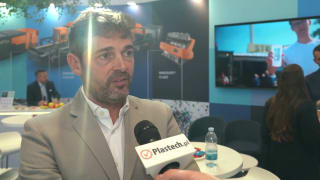
Stadler Anlagenbau GmbH has been awarded a major contract by Ecourbis Ambiental S.A. for the design and construction of the UTM Leste municipal solid waste sorting plant in São Paulo, Brazil. Scheduled for commissioning in August 2027, the facility is planned as a highly automated installation for the treatment of mixed municipal solid waste, combining mechanical sorting, drying and automated process control. According to the partners, UTM Leste is expected to be the most advanced municipal solid waste treatment plant in Latin America in terms of process technology, digitalization and integration into the local circular economy.
The plant is designed for a processing capacity of 135 tons per hour, or about 550,000 tons per year. From this input, UTM Leste is projected to recover 48,000 tons of recyclables, produce 260,000 tons of refuse-derived fuel, and generate 170,000 tons of organic material for biogas production. In total, more than 308,000 tons of waste per year are expected to be diverted from landfill disposal. The concept is based on Stadler's experience with European sorting plants, adapted to Brazilian waste composition and regulatory conditions, and is intended to support São Paulo's municipal waste strategy and Brazil's National Solid Waste Plan.
Partnership framework and strategic objectives
The collaboration between Stadler and Ecourbis Ambiental is positioned as a key element of São Paulo's strategy to increase resource recovery and reduce dependence on landfill disposal. Ecourbis Ambiental operates in municipal waste collection and treatment in São Paulo, while Stadler contributes engineering, equipment design and integration of automated sorting systems. The project combines Stadler's global engineering capabilities with operational experience from Stadler do Brasil and Ecourbis' local waste management expertise.
According to Ednei Rodrigues, superintendent of engineering, innovation and projects at Ecourbis Ambiental, the supplier selection was driven by the need for robust, reliable and efficient mechanized sorting. Rodrigues stated that the choice of Stadler reflects both its international position in mechanized sorting and its compatibility with Ecourbis Ambiental's innovation strategy. In his view, the cooperation is intended to ensure technology transfer, digitalization and process replicability, with the aim of reducing risks and consolidating São Paulo's role as a reference city in urban solid waste management.
Process design adapted to Brazilian waste streams
A central aspect of the project is the adaptation of Stadler's European waste treatment models to local Brazilian conditions. The company indicates that it has drawn on experience from other projects in Latin America, supported by engineering resources at its German headquarters. The design work includes adjustments to account for the specific composition of Brazilian municipal solid waste, local climate and requirements of the national regulatory environment.
Henrique Filgueiras, commercial director of Stadler do Brasil, underlines that Brazilian mixed waste streams differ significantly from those typically found in Europe. According to Filgueiras, they present higher organic content and moisture levels, a larger proportion of bulky and non-recyclable materials, and generally poorer gravimetric composition. These characteristics demand a process flow and mass balance that are specifically optimized for such input. He notes that achieving an appropriate balance between capital expenditure and operating costs is a key design criterion, particularly in light of the high costs of civil works in Brazil.
For this reason, Stadler is focusing on layout optimization and reinforcement of equipment robustness to ensure stable and reliable plant performance. The design approach aims to maintain throughput and sorting efficiency even under variable and challenging material composition. The plant will incorporate mechanical sorting technologies arranged to separate recyclables, organics and high-calorific fractions, while maintaining flexibility for future adjustments in operating parameters or input streams.
The UTM Leste facility will also be the first installation in Latin America to deploy the Stadlerconnect platform. This digital system uses artificial intelligence to support predictive maintenance, early blockage detection and real-time process optimization. By collecting and analysing process data, the platform is intended to increase equipment availability and overall plant efficiency.

Waste-to-energy: production of green RDF and biogas feedstock
An important innovation in the UTM Leste design is the integration of a drying line for organic fractions. Traditionally, these fractions are considered residual material with limited recovery options in conventional sorting plants. At UTM Leste, a part of this stream is to be processed into high-calorific refuse-derived fuel that the partners describe as green RDF, intended as an alternative to fossil fuels in compatible industrial processes.
Stadler and Ecourbis Ambiental indicate that approximately 132,000 tons of waste per year will be redirected from landfill disposal to alternative energy generation through green RDF. This is expected to contribute to São Paulo's efforts to increase the share of energy recovered from waste while reducing greenhouse gas emissions associated with landfilling. The remaining organic fraction, estimated at 170,000 tons per year, is earmarked as feedstock for biogas production, which forms part of the broader concept of an eco-park at the UTM Leste site.
For Ecourbis Ambiental, the project is a component of Brazil's National Solid Waste Plan, which prioritizes material recovery, energy recovery and the reduction of landfill usage. Rodrigues notes that the facility will operate within an eco-park structure integrating several technologies. In this configuration, different waste streams are intended to be channelled into reuse and energy recovery routes, supporting circularity targets and mitigation of greenhouse gas emissions.

Socioeconomic effects and role in the circular economy
Beyond the technical scope, the UTM Leste project is expected to have social and economic implications for São Paulo. The high degree of automation and plant modernization is anticipated to create several hundred direct and indirect jobs and to improve working conditions for plant operators compared to manual sorting practices. The facility is also intended to support the development of local markets for secondary raw materials such as plastics, metals and paper, as well as for renewable fuels derived from waste.
According to Rodrigues, the plant is designed to transform residual mixed waste into inputs for new production chains and renewable energy. Recovered plastics, metals and paper fractions are planned to be returned to manufacturing as secondary raw materials, while the produced RDF will serve as an energy carrier in place of conventional fuels in suitable industrial applications. In this way, UTM Leste is expected to contribute to closing material loops and reducing the need for extraction of primary resources.
The project is presented as being aligned with the latest update of Brazil's National Solid Waste Plan, which emphasizes circular economy approaches, expanded separate collection and recovery infrastructure. Within this policy framework, São Paulo is positioned by the partners as a potential demonstration site for circular economy solutions in Latin America. The city is described as a "living laboratory" and a platform for technological replicability for other Brazilian municipalities seeking to modernize their municipal solid waste systems.
Filgueiras underlines that UTM Leste is planned as not only the largest and most advanced waste treatment plant in Latin America, but also as a concrete illustration of Stadler's long-term concept of the circular economy. In this concept, municipal waste is treated as a source of materials and energy for multiple industrial sectors rather than as a disposal problem. If implemented as designed, the plant is expected to demonstrate how a large urban centre in the region can increase recovery rates, reduce landfilling and integrate waste treatment into a broader resource efficiency strategy.



